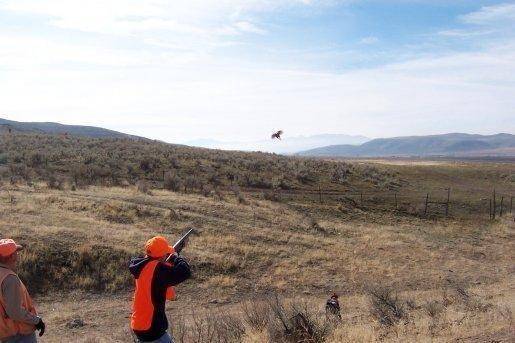This fall, young hunters will have a chance they’ve never had before in Utah. On Oct. 15 — three weeks before the regular pheasant and quail hunt starts — those who are 15 years of age or younger can hunt pheasants and quail in Utah.
After Oct. 15, the pheasant and quail hunt will close. The hunt will reopen — for hunters of all ages — on Nov. 5.
Justin Dolling, upland game and migratory game bird coordinator for the DWR, says holding a special youth pheasant and quail hunt — before the birds have been hunted and when adults aren’t allowed to hunt — is a great way to get young people interested in and involved in hunting. “Upland game hunting has been called the вЂgateway hunt,’” Dolling says. “Hunting upland game often gets young people excited about hunting in general.”
And since adults can’t hunt the same species the kids are hunting, it gives adults plenty of time to get the young hunter into the right habitat and to help the young hunter handle his or her firearm safely.
To participate in the youth hunt, a hunter must be 15 years of age or younger on Oct. 15 and a graduate of Utah’s Hunter Education course. He or she also needs a hunting license.
Finding a place to hunt
Finding a place to hunt is one challenge pheasant and quail hunters face in Utah. With the exception of Gambel’s quail in the Mohave Desert in southwestern Utah, most of Utah’s pheasant and quail hunting happens on private land.
That doesn’t mean you need to give up and stay home, though — several good options are waiting for you:
- Walk-In Access
Dolling says the state’s Walk-In Access areas are the first places you should consider. Walk-In Access areas are private property that’s been opened to public hunters and anglers through agreements the landowners have made with the DWR.
Dolling says the number of properties in the program keeps growing. “Many of the Walk-In Access properties have pheasants and quail on them,” he says. “If you’re looking for a place to hunt, the Walk-In Access areas are the first places I’d try.”
You can learn more about the Walk-In Access areas — and see which ones have pheasants and quail on them — on the Web at https://go.usa.gov/kmG.
More information about the Walk-In Access program itself is available at wildlife.utah.gov/walkinaccess.
- Wildlife Management Areas
The DWR manages several wildlife management areas in Utah. Many of these WMAs have pheasants on them. In addition to the pheasants that are already on the WMAs, some of the WMAs will receive some additional pheasants before Oct. 15.
You can learn more about Utah’s WMAs by reading the “Access to Wildlife Lands in Utah” book. The free book is available at www.wildlife.utah.gov/publications.
At one of the WMAs — the Pahvant WMA near Holden in central Utah — a special hunt will be held on Oct. 15. The number of young hunters who can participate in the hunt will be limited for safety reasons.
DWR Wildlife Biologist Lynn Zubeck says the first 50 youngsters who sign up will be allowed to enter the area first. “Then, as they finish and leave,” he says, “we’ll allow other young hunters to enter the unit until everyone has had a chance or we close at 7:17 p.m.”
Zubeck says the DWR will release a lot of pheasants on the WMA before the hunt. “There’s a good chance these kids will harvest a bird,” he says. To participate in the hunt, you need to sign up in advance by calling the DWR at (435) 865-6100 or visiting the DWR office at 1470 N. Airport Road in Cedar City.
The hunt on the Pahvant WMA will start at 8 a.m. There’s no cost to participate.
- Private land
Another option is getting written permission from a private landowner to hunt on his or her property.
Since most of Utah’s pheasant hunting happens on private land, Dolling says the youth pheasant hunting day will give young hunters and their parents experience in talking with landowners about hunting their property. “In the process,” he says, “these young hunters will learn more about the vital role landowners play in conserving habitat for wildlife.”
Dolling encourages you to be polite and understanding if a landowner doesn’t give you access to his or her property. “But if they do give you access to the property,” he says, “you’ll not only end up with a good place to hunt; you might end up with a new friend.”
Dolling says you should not wait until the morning of the hunt to approach a landowner about hunting his or her property. “You need to get this permission several days before the hunt begins,” he says.
- Finding pheasants and quail
Dolling says farm land in Box Elder, Weber, Davis, Tooele, Utah, Juab, Millard, Duchesne and Uintah counties are among the best places to find pheasants in Utah. Many of the wetlands near Utah Lake and Great Salt Lake also hold good numbers of pheasants.
California quail aren’t as widespread in the state as pheasants, but good numbers of California quail are found in parts of Duchesne, Uintah and Juab counties. Good numbers of California quail are also found in parts of Davis, Salt Lake and Utah counties, but most of these birds are within city limits where hunting is not allowed. Gambel’s quail are a little easier to access — they’re found almost entirely on public land in the Mohave Desert in southwestern Utah.
- More information
For more information about the youth pheasant and quail hunting opportunity, call the nearest Division of Wildlife Resources office or the DWR’s Salt Lake City office at (801) 538-4737.

